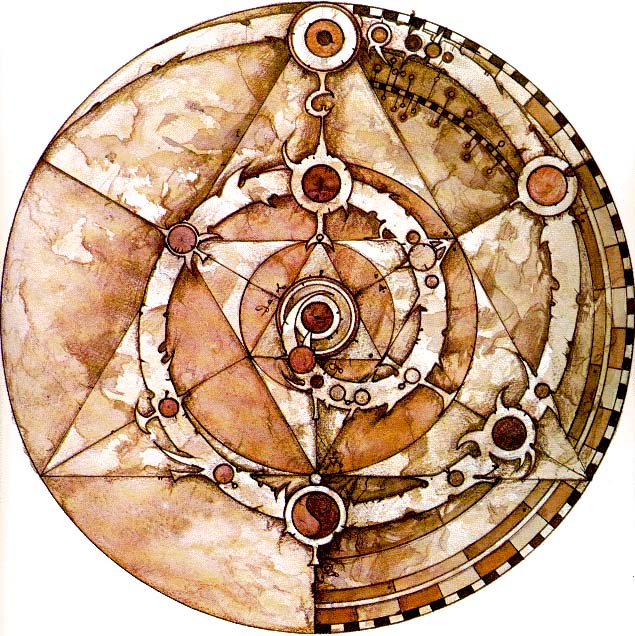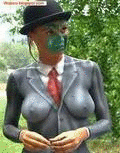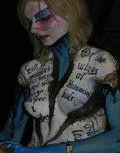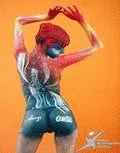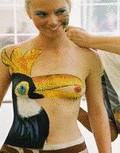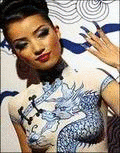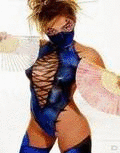



painting is called dul-Tsong-kyil-Khor, "mandala of colored powders. Construction of a sand painting, millions of grains of vegetable-dyed marble are paid on a platform for a period of several days or weeks. Flowers powder, herbs, or cereals, and powdered and colored stone can also be used. In the past, powdered semi-precious and precious stones such as lapis lazuli for blue and rubies for the reds, were also employed.
A
sand painting is a representation of the universe and contains traditional Tibetan Buddhist
symbolism, such as geometric shapes and ancient spiritual icons. It is created by monks of the Tibetan Buddhist tradition whenever they feel there is a need for the healing of the environment and all living beings. The act of constructing it is considered a religious practice and a path to enlightenment.
The subject of a sand painting is a mandala or cosmogram, the floor plan of a sacred mansion. The psychologist Carl Jung called the mandala a universal expression of the human subconscious. There are many varieties of mandalas, but most have three levels of meaning: outer, inner, and secret. The outer level represents the world in its divine form; the inner level depicts a map pointing toward enlightenment; the secret level represents the perfect balance of body and mind. The purpose of creating a sand painting is to achieve purification and healing on all three levels.
The Buddha wanted each living being to find peace and happiness and avoid suffering. Because everyone is different, he used a variety of techniques, all designed to lead to clarity of thought, purity of action, and a correct view of reality. These included meditation and a code of ethics whose goal was to avoid harming others, and helping them if possible. The practitioner would eventually come to realize the interdependence of all phenomena.
Tibetan Buddhists regard the tantric tradition as the highest path, requiring an ethical lifestyle and altruistic intentions. Various spiritual practices lead to enlightenment.
Each tantric system employs a particular mandala that represents a specific existential and spiritual approach. Three examples are that of the enlightened beings Avalokiteshvara, which stresses the importance of compassion; Manjushri, which represents wisdom; and Vajrapani, which emphasizes the need for courage and strength.
The Kalachakra tantric system was introduced to Tibet from India, and in recent years it has been brought to the West by exiled Tibetan lamas. The so-called Kalachakra Initiation is given to large groups of people--citizens of the kingdom of Shambala--using mandala sand paintings.
The process of mandala sand painting can be divided into four phases. The opening ceremony involves the lamas blessing the site and evoking the forces of goodness by chanting, mantras, and music. This takes about a half-hour.
They then draw the architectural lines of the mandala with a ruler, compass, and white ink pen on an approximately five-foot square wooden platform, which consumes the rest of the day.
The longest phase involves laying the colored sand, starting from the inside of the design and working outward. This symbolizes the growth of a child from the sperm and ovum into a living being who can experience the universe through his senses. The laying of the sand is accomplished by pouring it from a chak-pur or metal funnel. The monk holds the chak-pur in one hand and runs a metal rod along its rough surface. A vibration is created that causes the sand to flow and creates a cricket-like sound. Constructing a sand painting is a form of meditation for the monks. They work quietly, often in awkward positions, for hours at a time, the tops of their bodies wrapped in red cloth. Occasionally they take a break to discuss the work-in-progress with each other.
The mandala, which is not considered art by the monks, is destroyed soon after it is completed--swept up first from the outside, and toward the center--in a colorful and usually crowded ceremony. This pattern of destruction symbolizes how all returns to the source at the heart center at the time of old age and death. It also draws attention to life's impermanence and the empty nature of all phenomena (everything emerges from nothingness and returns to it). All the sand is collected and placed in an urn. Half is given to the audience for healing purposes, and the rest transported to a nearby body of water and thrown in. The waters carry the healing blessing to the ocean, and then on to the rest of the world for further healing and the dissemination of universal goodness.
Anyone who participates in or witnesses the creation and destruction of a mandala sand painting is believed to be purified, uplifted, and enlightened by the sacred energies of the spirits, deities, buddhas, and saints who are evoked. The physical area in which the mandala is constructed also becomes blessed.
One of the most important mandala sand paintings is said to have been created by the Buddha himself. It is called The Buddhist Wheel of Life, or the Sipay Khorlo Mandala. The Buddha designed this mandala as a lesson about the cyclic nature of existence. This is seen in the twelve links in the outer ring of the mandala, which demonstrate a doctrine called dependent origination. That is, each link is dependent on the previous link, and leads to the next link.
The function of the twelve links of dependent origination is to tie the living to continual birth and rebirth, or reincarnation, in the six realms that are depicted in the middle ring. Attainment of nirvana or enlightenment is the only thing that will allow the individual a rest from this endless cycle of life and death among the realms. The inner ring's dark half depicts demons whose function is to push the dead spirits into hell. The light half, in contrast, shows fortunate spirits rising to heaven.
The center contains three animals. The bird symbolizes desire, the pig ignorance, and the snake anger. These are considered the three poisons that fuel the twelve links of dependent origination.
In the past, a few monasteries kept one sand painting permanently displayed on their grounds because the healing and purification of the world were not yet completely fulfilled. In today’s Tibet, which is a part of communist China, there are strict religious prohibitions, and mandalas probably are not constructed there, except possibly as a token display of the religious freedom that does not exist. Most sand paintings these days are being constructed by exiled Tibetan lamas at Western museums and also in India, where the Dalai Lama, the spiritual leader of Tibetan Buddhism, has lived in exile for many years.







